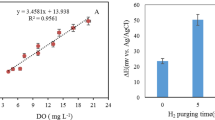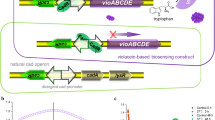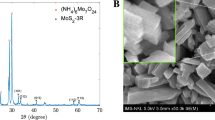Abstract
Electrochemically active bacteria (EAB) have the ability to transfer electrons to electron acceptors located outside the cell, and they are widely present in diverse environments. In spite of their important roles in geochemical cycles, environmental remediation and electricity generation, so far, only a limited number and types of EAB have been isolated and characterized. Thus, effective and rapid EAB identification methods are highly desirable. In this protocol, we describe a photometric protocol for the visualization and high-throughput identification and isolation of EAB. The protocol relies on the fast electron acquisition and color change ability of an electrochromic material, namely a tungsten trioxide (WO3) nanorod assembly. The extracellular electron transfer (EET) from EAB to the WO3 nanorod assembly probe is accompanied by a bioelectrochromic reaction made evident by the color change of the probe. This protocol enables researchers to rapidly identify EAB and evaluate their EET ability either qualitatively with the naked eye or quantitatively by image analysis. We have also successfully used this protocol to isolate EAB from environmental samples. The time needed to complete this protocol is ∼2 d, with the actual EAB identification process taking about 5 min.
This is a preview of subscription content, access via your institution
Access options
Subscribe to this journal
Receive 12 print issues and online access
$259.00 per year
only $21.58 per issue
Buy this article
- Purchase on Springer Link
- Instant access to full article PDF
Prices may be subject to local taxes which are calculated during checkout




Similar content being viewed by others
References
Reguera, G. et al. Extracellular electron transfer via microbial nanowires. Nature 435, 1098–1101 (2005).
Rittmann, B.E., Krajmalnik-Brown, R. & Halden, R.U. Pre-genomic, genomic and postgenomic study of microbial communities involved in bioenergy. Nat. Rev. Microbiol. 6, 604–612 (2008).
Fredrickson, J.K. et al. Towards environmental systems biology of Shewanella. Nat. Rev. Microbiol. 6, 592–603 (2008).
Tender, L.M. et al. Harnessing microbially generated power on the seafloor. Nat. Biotechnol. 20, 821–825 (2000).
Nielsen, L.P. et al. Electric currents couple spatially separated biogeochemical processes in marine sediment. Nature 463, 1071–1074 (2010).
Nealson, K.H. & Saffarini, D. Iron and manganese in anaerobic respiration: environmental significance, physiology, and regulation. Annu. Rev. Microbiol. 48, 311–343 (1994).
Tiedje, J.M. Shewanella-the environmentally versatile genome. Nat. Biotechnol. 20, 1093–1094 (2002).
Sharma, M. et al. Bioelectrocatalyzed reduction of acetic and butyric acids via direct electron transfer by a mixed culture of sulfate-reducers drives electrosynthesis of alcohols and acetone. Chem. Commun. 49, 6495–6497 (2013).
Rabaey, K. & Rozendal, A.R. Microbial electrosynthesis-revisiting the electrical route for microbial production. Nat. Rev. Microbiol. 8, 706–716 (2010).
Bond, D.R. et al. Electrode-reducing microorganisms that harvest energy from marine sediments. Science 295, 483–485 (2002).
Bretschger, O. et al. Current production and metal oxide reduction by Shewanella oneidensis MR-1 wild type and mutants. Appl. Environ. Microbiol. 73, 7003–7012 (2007).
Taratus, E.M., Eubanks, S.G. & DiChristina, T.J. Design and application of a rapid screening technique for isolation of selenite reduction-deficient mutants of Shewanella putrefaciens. Microbiol. Res. 155, 79–85 (2000).
Payne, A.N. & DiChristina, T.J. A rapid mutant screening technique for detection of technetium [Tc(VII)] reduction-deficient mutants of Shewanella oneidensis MR-1. FEMS Microbiol. Lett. 259, 282–287 (2006).
Richter, H. et al. Lack of electricity production by Pelobacter carbinolicus indicates that the capacity for Fe(III) oxide reduction does not necessarily confer electron transfer ability to fuel cell anodes. Appl. Environ. Microbiol. 73, 5347–5353 (2007).
Zuo, Y. et al. Isolation of the exoelectrogenic bacterium Ochrobactrum anthropi YZ-1 by using a U-tube microbial fuel cell. Appl. Environ. Microbiol. 74, 3130–3137 (2008).
Fedorovich, V. Novel electrochemically active bacterium phylogenetically related to Arcobacter butzleri, isolated from a microbial fuel cell. Appl. Environ. Microbiol. 75, 7326–7334 (2009).
Biffinger, J. et al. Characterization of electrochemically active bacteria utilizing a high-throughput voltage-based screening assay. Biotechnol. Bioeng. 102, 436–444 (2009).
Hou, H. et al. Microfabricated microbial fuel cell arrays reveal electrochemically active microbes. PLoS ONE 4, e6570 (2009).
Yuan, S.J. et al. A photometric high-throughput method for identification of electrochemically active bacteria using a WO3 nanocluster probe. Scientific Rep. 3, 1315 (2013).
Wang, J.M. et al. Synthesis, assembly, and electrochromic properties of uniform crystalline WO3 nanorods. J. Phys. Chem. C 112, 14306–14312 (2008).
Santato, C. et al. Crystallographically oriented mesoporous WO3 films: synthesis, characterization, and applications. J. Am. Chem. Soc. 123, 10639–10649 (2001).
Wang, J.M., Khoo, E., Lee, P.S. & Ma, J. Controlled synthesis of WO3 nanorods and their electrochromic properties in H2SO4 electrolyte. J. Phys. Chem. C 113, 9655–9658 (2009).
Laroussi, M., Richardson, J.P. & Dobbs, F.C. Effects of nonequilibrium atmospheric pressure plasmas on the heterotrophic pathways of bacteria and on their cell morphology. Appl. Phys. Lett. 81, 772–774 (2002).
Li, G. et al. Genetic effects of radio-frequency, atmospheric-pressure glow discharges with helium. Appl. Phys. Lett. 92, 221504 (2008).
Granqvist, C.G. Handbook of Inorganic Electrochromic Materials (Elsevier, 2002).
Nevin, K.P. et al. Microbial electrosynthesis: feeding microbes electricity to convert carbon dioxide and water to multicarbon extracellular organic compounds. mBio. 1, e00103–10 (2010).
Wang, C.J. et al. Survivin expression quantified by image Pro-Plus compared with visual assessment. Appl. Immunohistochem. Mol. Morphol. 17, 530–535 (2009).
Tatro, E.T. et al. Short-term recognition memory correlates with regional CNS expression of microRNA-138 in mice. Am. J. Geriatr. Psychiatry 21, 461–473 (2013).
Yuan, S.J. et al. Degradation of organic pollutants in a photoelectrocatalytic system enhanced by a microbial fuel cell. Environ. Sci. Technol. 44, 5575–5580 (2010).
Herrero-Hernandez, E., Smith, T.J. & Akid, R. Electricity generation from wastewaters with starch as carbon source using a mediatorless microbial fuel cell. Biosens. Bioelectron. 39, 194–198 (2012).
Wang, C.T., Chen, W.J. & Huang, R.Y. Influence of growth curve phase on electricity performance of microbial fuel cell by Escherichia coli. Int. J. Hydrogen Energy 35, 7217–7223 (2010).
Acknowledgements
The authors thank the National Nature Science Foundation of China (51129803) and the Program for Changjiang Scholars and Innovative Research Team in University, China for the partial support of this study. They also thank Professor K.H. Nealson from the University of Southern California for kindly providing S. oneidensis MR-1 wild type and its mutant strains.
Author information
Authors and Affiliations
Contributions
S.-J.Y., W.-W.L., G.-P.S., Z.-H.T. and H.-Q.Y. designed the experiments; S.-J.Y., W.-W.L., Y.-Y.C., H.H., J.-J.C., Z.-Q.L. and F.Z. conducted the experiments; S.-J.Y., W.-W.L., G.-P.S., Y.-Y.C., F.Z., Z.-H.T., J.-J.C. and H.-Q.Y. wrote and edited the manuscript. All authors contributed to discussion about the results and implications of the manuscript.
Corresponding authors
Ethics declarations
Competing interests
The authors declare no competing financial interests.
Rights and permissions
About this article
Cite this article
Yuan, SJ., Li, WW., Cheng, YY. et al. A plate-based electrochromic approach for the high-throughput detection of electrochemically active bacteria. Nat Protoc 9, 112–119 (2014). https://doi.org/10.1038/nprot.2013.173
Published:
Issue Date:
DOI: https://doi.org/10.1038/nprot.2013.173
This article is cited by
-
Pseudomonas aeruginosa’s greenish-blue pigment pyocyanin: its production and biological activities
Microbial Cell Factories (2023)
-
Generation of green electricity from sludge using photo-stimulated bacterial consortium as a sustainable technology
Microbial Cell Factories (2023)
-
Cloud-based smartphone-assisted chemiluminescent assay for rapid screening of electroactive bacteria
Science China Technological Sciences (2023)
-
Plant secondary metabolites induced electron flux in microbial fuel cell: investigation from laboratory-to-field scale
Scientific Reports (2020)
-
Enhancing bioelectricity generation in microbial fuel cells and biophotovoltaics using nanomaterials
Nano Research (2019)
Comments
By submitting a comment you agree to abide by our Terms and Community Guidelines. If you find something abusive or that does not comply with our terms or guidelines please flag it as inappropriate.



